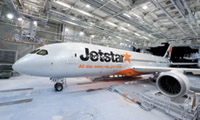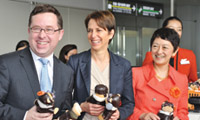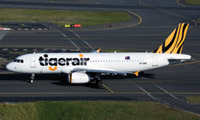Cover Story
HRDLICKA'S SIX STAR CHALLENGE
Running one airline is tough enough. Running six is a monumental task. But Jetstar Group chief executive, Jayne Hrdlicka, takes it in her stride. She relishes the challenges - and there are more to come.
September 1st 2013
Jetstar Hong Kong was planned to be in the air by now. Instead, it is facing regulatory issues and opposition lobbying from rivals such as Cathay Pacific Airways, who question the carrier’s status as a local airline under the Hong Kong Special Administrative Region’s Basic Law.Read More »
 |
| 'We are very confident we are going to get our AOC and all the regulatory approvals to be a Hong Kong designated airline. The timing is a bit out of our control' |
| Jayne Hrdlicka Chief Executive Jetstar Group |
Jetstar Group boss Jayne Hrdlicka sweeps the accusation aside as she surveys her stable of operations in Australia, New Zealand, Singapore, Japan, Vietnam and Hong Kong, when she spoke to Orient Aviation last month in Melbourne.
“Every one of our airlines operates as a local airline. Our Australian business operates as an Australian business. We now have a great team in New Zealand. We have a chief executive in Singapore, who runs our Singapore operation, and who is building the Southeast Asian network and our profile there.
“Vietnam, again, is a very independent business that leverages all the technical know-how that we bring to the market as well as the benefits of scale, but it’s a Vietnam airline operation. The same thing is happening in Japan and Hong Kong,” she said.
“We have a local chief executive. We’ve built the Hong Kong team. We are running the business as you would run a business ready for operational launch.
“We have a fantastic local shareholder in Shun Tak [controlled by gambling tycoon, Stanley Ho, which recently bought a 30% stake in the Qantas Airways / China Eastern Airlines joint venture] which brings great infrastructure leverage and great local market wisdom [to us] in terms of building the tourism trade we need to develop a low fares market.
“They are passionate and committed to the development of a local market just as we are. That business will operate as a Hong Kong-based airline.”
Hrdlicka said she is not phased by the delays in receiving regulatory approval that caused postponement of a mid-year launch for Jetstar Hong Kong.
“We are very confident we are going to get our AOC [Air Operators Certificate] and all the regulatory approvals to be a Hong Kong designated airline. The timing is a bit out of our control,” she said.
“We have submitted the application to the authorities. We expect it to be gazetted in the next four or five weeks [September].
The new launch date is expected to be at the end of this year. “If we have to wait an extra couple of months… it is what it is,” said Hrdlicka.
 |
| Jetstar: the first of its 14 B787s rolls out of the paint shop in Seattle |
The Jetstar Group boss has more than enough challenges to face in the coming year. Jetstar Pacific in Vietnam and Jetstar Japan, currently operating domestically, will be stretching their wings onto international routes. In New Zealand, where the airline last year suffered operational difficulties and customer complaints about its service, work is well underway on rebuilding its brand reputation.
In Australia, where domestic over-capacity has hit everyone, Jetstar must take on a revitalized no-frills rival, Tigerair (formerly Tiger Airways), now majority-owned by Virgin Australia. The low-cost carrier (LCC), with a former Qantas executive, Rob Sharpe, as its CEO, is back in business after being grounded for safety reasons early last year.
Also, the first of a much-delayed order of 14 B787 Dreamliners will arrive at the carrier later this month to replace its A330s.
Despite its issues and complexities, Jetstar is one of the largest contributors to Qantas’ profits, topped only by the mainline airline’s frequent flyer programme and its full-service domestic operations.
In the six months to December 31 (full year figures were expected at press time), the Qantas Group reported an after-tax profit of A$111 million, with its international arm losing $91 million. Domestic operations returned a profit of $218 million, down from $328 million in the same period a year earlier. Qantas’ loyalty scheme made a $137 million profit. Meanwhile, the Jetstar group of carriers was $128 million in the black.
At present, Hrdlicka has a fleet of 104 aircraft under her control and a network of more than 60 destinations in 16 countries.
| Career track Fate deals Hrdlicka the aviation card Jayne Hrdlicka, the 51-year-old daughter of a Czechoslovakian father who fled to the U.S. in 1948 and became a successful lawyer, grew up in a small town near Wichita, Kansas. After graduating from college in Colorado, she worked at big four global accounting firm Ernst & Young and then joined Boston management consultancy, Bain & Company. After more than two years at Bain she went to work on a company “turnaround” for a former client at Bain, a private equity-owned business called SkyBox. It specialized in collectable products such as trading cards for sporting brands like the National Basketball League, Major League Baseball, Marvel and Disney. Within six months, at the age of 28, she was running the business’s operations. “I think I had managed three people in my career before that experience. All of a sudden I was managing what at the time was a US$550 million cost base that needed to be something dramatically less,” she recalled. “I don’t think I slept much. I thought I really worked hard as a consultant. I had no idea how hard it was until you have payroll and people’s livelihoods on your shoulders.” The experience led to a move to Australia in 1994 to work for the trading cards business, before returning to Bain four years later. By 2000, she was one of seven directors in Australia at the consultancy firm. It was there that fate stepped in. Her first client was Alan Joyce, the Qantas Group CEO, who was then working at Ansett Airlines. In 2010, Joyce, who moved to Qantas when Ansett folded, offered her a job as head of strategy and information technology. She was appointed head of the Jetstar Group last year to replace Bruce Buchanan who retired to set up a family-run marketing business. |
Sixty nine of the planes service Jetstar Airways: 53 A320s (nine in New Zealand), six A321s and 10 A330-200s. Jetstar Asia in Singapore operates 17 A320s, Jetstar Japan has 13 A320s and Jetstar Pacific in Vietnam, flies five A320s.
Profitability is improving after some tough years. Jetstar Asia saw an 80% plunge in its income in 2011 because of high fuel costs and intense competition. The profits have returned, said Hrdlicka.
“Each one of our businesses plays a role in the portfolio. The Singapore business is important for a variety of reasons. It is a gateway into Southeast Asia for us, which plays an important role for the low fares consumer in the marketplace,” she said.
 |
| All dolled up: Left to right Qantas Group CEO, Alan Joyce, Jayne Hrdlicka and Jetstar Japan CEO, Miyuki Suzuki, at the launch of the Japanese LCC |
Jetstar will increase its Singapore fleet from 17 to 21, with more to come, said the chief executive. “We are looking at the growth opportunities into Indonesia from Singapore. That’s significant with rights opening up. There will be more growth than we had anticipated,” added Hrdlicka.
One key to the group’s improvement has been partnerships with full-service carriers. Apart from Qantas and Emirates Airline, the Jetstar Group has 25 interline partnerships with airlines ranging from KLM and British Airways to American Airlines, Air Canada, Air France, Cathay Pacific Airways, Lufthansa, Qatar Airways and Turkish Airlines.
Another troubled operation, Jetstar Pacific in Vietnam, is also on the up and up, said Hrdlicka. Dogged by losses since Qantas bought a cornerstone equity in the airline in 2007, Vietnam Airlines (VNA) last year became the majority shareholder in a joint venture with Jetstar.
The new shareholder partnership followed a delicate period in Jetstar Pacific’s development during which two Qantas executives were forced to stay in Vietnam following losses the airline suffered from fuel hedging.
The new partnership with VNA has “come together very well”, according to Hrdlicka. “There has been a big restructuring of costs and a change in the fleet to A320s. We will add another two aircraft to the fleet by the end of 2013, taking it to seven. There will be more growth in the first half of next year,” she said.
International routes are expected to begin by year end as Jetstar Pacific builds a regional portfolio.
Hrdlicka is particularly excited about Jetstar Japan, a joint venture with Japan Airlines, Mitsubishi Corporation and Century Tokyo Leasing Corporation. Launched last year in an essentially virgin LCC market, many analysts predicted it would take years to develop the carrier.
With All Nippon Airways (ANA)-owned Peach Aviation and AirAsia Japan, a joint venture between ANA and Malaysia’s AirAsia and Jetstar Japan all entering the market within months of each other, the general view was the Japanese travel culture was not conducive to no-frills flying.
The ANA-AirAsia partnership has since broken up, but budget competition is intensifying, with ANA re-launching the former LCC under a new name without AirAsia as a partner. AirAsia has promised to return to Japan with its own venture. China’s Spring Airlines is also considering a Japanese budget carrier.
 |
| A rebranded tigerair is back in service after being grounded for safety reasons and is one more rival for Jetstar |
Hrdlicka said the naysayers were wrong. “Japan has a population of 120 million people and a steady economy. There are very few inexpensive options to travel domestically in Japan. We are opening up a low fares market,” she said.
“People in Japan are no different to people in Australia. They would like to fly to visit family and friends. They would like to fly to have new adventures domestically in Japan. They would like to have the ability to grow small businesses and to do that at a price they can afford. And today that’s possible. A year ago that wasn’t possible.
“We have13 aircraft and we’ll have 21 by the end of June next year. We are going from strength to strength. We are just about to fly our two millionth customer. It’s a great little business.”
Statistics show domestic passenger numbers rose 8% in Japan in the past 12 months. “That’s not because the full service carriers have been doing anything different, it’s because low fares have come into the marketplace, which has created a new segment of the market,” said Hrdlicka.
“We will see continued steady growth. In Japan, we see the highest customer score cards of any of our airlines.”
Jetstar Japan will begin international operations by the end of the year, although Hrdlicka won’t disclose potential destinations. They will almost certainly include China and Korea.
The airline has become the first LCC in its market to enter the freight business. Along with Air Logistics Japan, it is offering freight on services from Tokyo Narita and Osaka to Sapporo, Fukuoka and Okinawa. More domestic routes are planned, as well as the introduction of freight services on international services to link with other airlines in the group.
“We are already flying cargo in many parts of the network. It is an important part of the mix. You’ve got a fixed cost and flying dead belly space doesn’t make a lot of sense when you’re an LCC,” said Hrdlicka.
Flying freight adds to ancillary revenue, already around 31% of Jetstar revenue and rising.
There is little doubt there is more to come from Jetstar when it concerns budget brands. Hrdlicka won’t talk about the possibility of a Jetstar India or the like elsewhere, but, she reiterates, Jetstar is a growth business.
“We won’t be the best low fares airline in the region if we don’t have ambitious plans. We’re not making commitments about the locations of the next big platforms. Our focus is on consolidating what we have, which sets us up for the inevitability of the next piece and the piece after that,” said Hrdlicka.
“There are strategic areas we will eventually need to cover, but there are creative ways of going about that.”
At home in Australia, Hrdlicka recognizes it is a tough consumer market and that people are holding back spending because of concerns about economic conditions and political uncertainty (Australian elections take place on September 7).
Seats added throughout last year were well above expectations despite Virgin’s increased presence in the market and Tigerair’s return to the air. “All those things came together and made a big impact on capacity growth relative to the previous year and relative to the underlying demand,” she said.
“We are very focused on innovation and change in terms of the offer for low fare consumers. It’s nice to know there is good competition out there because it always sharpens everybody’s game.”
As for the B787, Jetstar will have three by the end of this year. Up to five more are expected to arrive in 2014. After an initial launch on domestic routes, the B787s are planned to start international services by year’s end. Possible offshore destinations, yet to be confirmed, are Hawaii, Singapore and Japan.
The Dreamliner raises the possibility of more longer-haul flying, although there will be no rush towards distant destinations such as Europe.
“We have ideas where it might take us. We have a hit list we are working on. It will certainly lead to new opportunities for Jetstar from a long-haul flying standpoint,” said Hrdlicka.
“We are very focused on what we think will happen, but we are also very disciplined about taking steps where we know we have solid ground underneath our feet.”
| ‘Challenges’ for LCCs in China Asia’s low-cost carriers are striving to expand their networks into China, but are finding that budget flying in the region’s biggest market is no easy task. Jetstar Group chief, Jayne Hrdlicka, cited inconvenient slot times as one factor, in a panel discussion at the CAPA Australia Pacific Summit in Sydney last month. An example was Jetstar’s service from Guangzhou to Singapore, which departs at 1.20am and arrives in Singapore at 5.25am. “It’s one of the most challenging parts of the network,” she said. Operating in China with a low-cost model, based on high utilization of aircraft, was proving extremely difficult, said Hrdlicka. “I don’t think any of us have quite nailed the opportunity in China yet,” she added. Another panelist, AirAsia X chief executive, Asran Osman-Rani, highlighted problems created by Chinese military’s control of its country’s airspace. Sometimes aircraft circled above an airport for more than an hour, even when there was no other traffic waiting to land, he said. Darren Wright, Australian manager of Singapore Airlines-owned Scoot, cited the occasion when an airline was given a 3am landing slot for an international service, but with customs and immigration staff not reporting for duty until 7am, passengers had to sit on the plane for four hours until the services opened. |